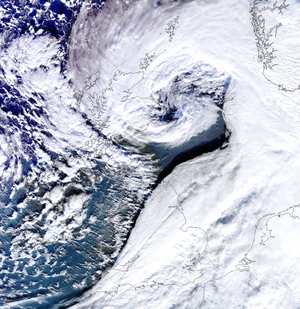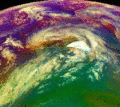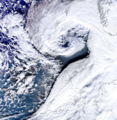European windstorm facts for kids

A European windstorm is a powerful storm that affects Europe. These storms are also called extratropical cyclones. They form when areas of very low air pressure move across the North Atlantic. They usually head towards northwestern Europe.
These storms happen most often in the winter months. Low pressure areas are common over the North Atlantic. Sometimes, they even start as storms called "nor'easters" near the New England coast in the United States.
Contents
Where European Windstorms Go
European windstorms usually travel past the northern parts of the British Isles. They then move towards the Norwegian Sea. If they move further south, they can affect almost any country in Europe.
Countries Most Affected
The countries most often hit by these storms include:
However, they can also affect countries in central, northern, and western Europe.
Impact of European Windstorms
These strong storms can cause a lot of damage. They lead to significant costs for countries and people.
Financial Costs of Storms
European windstorms cause about €1.9 billion in economic damage each year. They also lead to around €1.4 billion in insurance costs every year. This data comes from the period between 1990 and 1998.
Only US hurricanes cause more insurance costs than European windstorms. This makes them one of the most expensive natural disasters in the world.
Images for kids
-
2015 list of storm names from UK Met Office and Met Éireann
-
A fictitious synoptic chart of an extratropical cyclone affecting Great Britain & Ireland. The blue and red arrows between isobars indicate the direction of the wind and its relative temperature, while the "L" symbol denotes the center of the "low". Note the occluded cold and warm frontal boundaries.
-
Contemporary picture of the flood that struck the North Sea coast of Germany and Denmark in October 1634.
See also
 In Spanish: Borrasca profunda europea para niños
In Spanish: Borrasca profunda europea para niños







